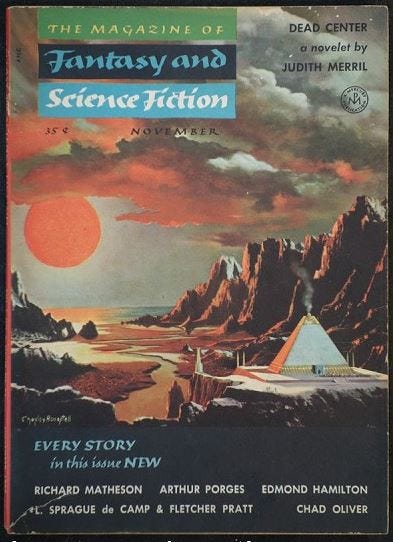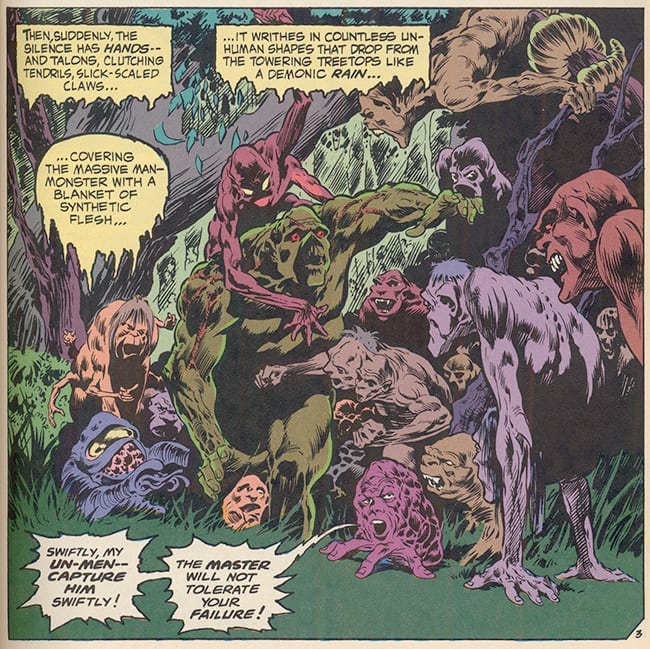Image of the Week: Chesley Bonestell
Plus, death by white dwarf star
This week’s top art is by Chesley Bonestell, one of the greats, albiet an older space artist who predates all the 70s-era artists I usually focus on.

This particular artwork strikes me as ahead of its time even for Bonestell, and would fit right into the 1970s. But it’s actually from 1948.
I got in touch with Chesley Bonestell scholar Melvin Schuetz to find out what the art is actually depicting, and he, very kindly, explained in some depth:
“Sadly, the original painting has been lost. If it still exists somewhere, it would be at least 72 years old. Its first publication was in Pic magazine in December 1948. It accompanied a John W. Campbell article entitled, "We Are Not Alone." The illustration was reproduced there in "duotone," not in full color. It would appear in full color in 1964, in the book Beyond the Solar System, which was written by Willy Ley, illustrated by Chesley Bonestell, and published by the Viking Press. The Tumblr photo you found is definitely a scan of the illustration from the Ley book.
The illustration in Pic and BSS shows Antares with an undefined surface. A modified version of the illustration, showing Antares with a clearly-defined surface, was published in November 1954, on the front cover of The Magazine of Fantasy and Science Fiction. I do not know why F&SF chose to alter the image that way; every Bonestell enthusiast I have ever met and asked about this painting has preferred the original version over the version on the F&SF cover!”
The Magazine of Fantasy and Science Fiction cover in question, with the sharply defined red star:

And here’s the exact caption used in Beyond the Solar System:
“Antares, a red supergiant, as viewed from a hypothetical planet at a distance of about 3240 million miles. Like the other red supergiant stars, Antares does not have a clearly defined surface.”
***
Unrelated to anything else, check out this link for a fun set of 1947 Bonestell illustrations depicting a series of potential apocalypses.
Here are a few of my favs, from left to right: The Sun’s expansion boils off Lake Michigan; A white dwarf star’s massive gravity sucks up everything; and Rio de Janeiro freezes after a dark star “kidnaps” Earth from the Sun.

***
Here’s an excerpt from a letter Anne McCaffrey wrote to John Schoenherr. The main gist of the letter is praise for his illustrations to her Dragonriders of Pern stories, published in three issues of Analog magazine from late 1967 and early 1968.
But I’m excerpting another section, which offers a little insight into how science fiction was perceived at the time, as well as a look at some friction at the McCaffrey household:
“I would very much still like to meet you and thank you for your superb dragons. When you return to civilization, I hope we can arrange a luncheon or dinner in town. My husband and your wife can talk about things others than science-fiction which bores my husband although he is very interested in Fine Art (which is why he isn’t interested in s-f). That sounds rather stuffy, doesn’t it? Well, looks that way on paper.”
I went straight to her wikipedia page after reading this, and there’s a happy ending here: They divorced in 1970.
Here’s McCaffrey’s favorite Schoenherr illustration — she writes: “How did you manage to convey that foolish bronze’s tender regard and lack of menace in black and white, no less. Superb.”

***
Entertaining 1982 interview here with comics artist Bernie Wrightson. Wrightson’s pretty open, personable, and willing to go on record with even his strong opinions, something that always makes for a great interview.
Highlights including him hyping up the movie Creepshow while dissing The Shining (“Kubrick’s movie was very prissy somehow.”) Here he is explaining how comics differ from book illustrations, with a Jim Steranko critique tossed in for good measure:
“It seems to me that a comic book is enjoyed spontaneously in direct ratio to how spontaneously it is produced. And I’m not saying that ‘quick comics is good comics,’ because you can work a long time on a comic book and still be spontaneous, but it does reach a point of overwork. I love Steranko’s work, and always have. Especially his comic stuff. But, too many times, I think he really overworks it and just cerebralizes it a little too much and, I don’t know about the rest of his audience, but he loses me when that starts to happen.”
Actually, a lot of the interview is Wrightson dissing people, and then apologizing and explaining that that’s just his opinion. Here he is just destroying an EC Comics artist:
“I’m more excited about Kamen than Krigstein. But then, you have to understand. I’m always going to be more of an illustrator than a storyteller. And I look at the drawing and I don’t really like Krigstein’s drawing. And if I don’t like the drawing I don’t read the story. And if you don’t read the story you can’t comment on the storytelling. And I do read the Krigstein stories, but I’m really turned off by the drawing.”
His thoughts on Jack Kirby?
GROTH: Are you a big fan of Kirby’s and that whole school?
WRIGHTSON: No, never have been.
Stan Lee?
“Never really warmed up to Stan [Lee] a whole lot. I always thought of Stan as this kind of grinning idiot PR man that didn’t write real good comics, let’s face it.”
Don’t worry, he disses his own past work as well. His thoughts on a series where he used a different style and approach for every story: “Yeah. I think that was maybe a little pretentious. I should have just concentrated more on telling the story, instead of worrying about technique and all.”

Okay, I’m spending too much time on the negative stuff. Wrightson also has insights about his career, like the influence his terrible Catholic school upbringing has on his interest in horror (“A hell of a lot”), as well as a smart-if-vague take on where his style comes from (“I’ve been influenced by so many people, living and dead, that it’s hard to say where anything comes from. It’s all this big hodgepodge”).
Wrightson does have a high opinion of artist Jim Warren, sharing this highly entertaining story about the guy:
A funny thing happened soon after I started working with him. I was going to move, I found this great place. I was going to move out of my apartment and into an old church. Didn’t have enough money for the deposit for all this, so I went into Warren and said can I have an advance on the job I’m doing for you because I want to move into this place, and explained the whole thing to him. He said, “I never give advances to people, and here’s why.”
And for an hour and a half he goes into this tirade about why he will not give anybody an advance; because you can’t trust artists, not me personally, but generically, artists are irresponsible people blah, blah, blah. On top of that, what if I give you this money for an advance and you have all your good intentions and everything of paying me back and then you get hit by a truck and you never finish the job. And I’m out the money, and I’m out the work blah, blah, blah. For an hour and a half he goes through this whole thing. I’m sitting there getting depressed as hell because I’m not going to get the money and then he finally says, “So that’s why I won’t give you an advance, but I will give you a personal loan.” And it was for something like $400. He writes me a personal check. Everything is fine. I walk out of his office, go and get the place. Couple of weeks later, I finish the job, turn it in, he pays me, I deposit the check, wait for it to clear, and pay him back his $400, we’re square.
Then about a month after that, I break up with the girl that I moved into the church with and I’m moving back to the city. I’m going to move to Queens. Again, I’m strapped for money. I go in to see Warren, and I say “Jim, I know this is awful close on the heels of the last time, but I really have to ask you for a personal loan.” He said, “I never give anybody personal loans.” [Laughter.] For an hour and a half he sits there and gives me the same reasons why he doesn’t give anybody personal loans, and they’re the same reasons he doesn’t give an advance. He goes through the whole thing, and at the end he says, “But I will advance you on the job you’re working on.” [Laughter.] He’s a maniac. [Laughter.]
Anyway, good interview, if a bit long. See if you can make it to the section where Wrightson defends his argument that a row of severed foot is creepier than a row of severed heads. He convinced me by the end of it.